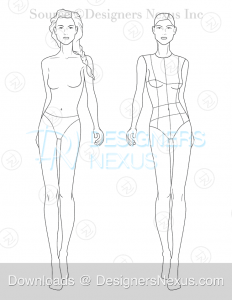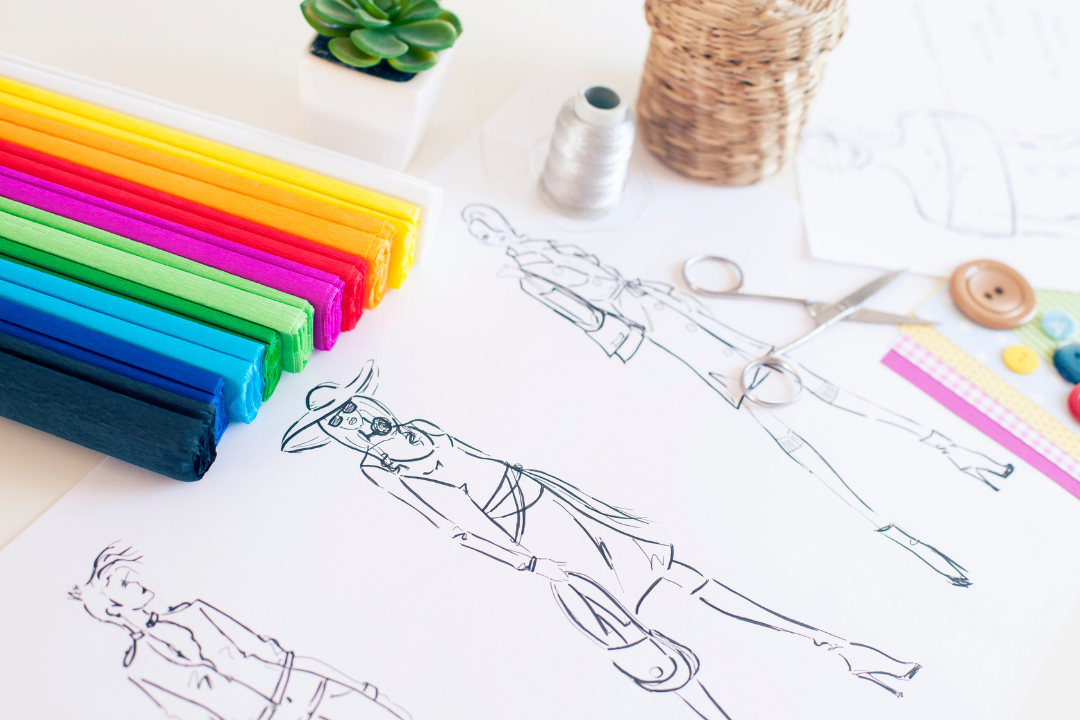
- For drawing clothes you don’t need bodies in flight, dancing, jumping and others, so I’m sure that there will be no difficulties in the process of self-education that you could not solve yourself! Cute anime girl clothes drawings. How to draw dresses fashion easy. Shirt drawing reference female. Skirt drawing reference. Cloth folds drawings.
- Fashion Designer, Art Class Teachers' Certificate, South Kensington. Chief Points Necessary to Achieve Success - How to Draw the Figure - Line and Wash Work - Materials Required - Fabrics, Millinery and Furs - How they may be Indicated most Successfully and Realistically. There are three essentials in fashion drawing, without which it is impossible to achieve success.
- A tutorial on drawing a female fashion figure pose. This tutorial came about from reading an article on the entrepreneurial journey of a fashion brand to get funding. I have a clothing line of my own at so thought it interesting. Reading through the article led me to the.
- Find fashion drawing stock images in HD and millions of other royalty-free stock photos, illustrations and vectors in the Shutterstock collection. Thousands of new, high-quality pictures added every day.
Draw the balance line. This is a the first line of your sketch, and it represents your model’s center of gravity. Draw it from the top of the head to the tip of the toes, along the backbone of your croquis. Now draw an oval to represent the head. This is the base of your croquis, and from this, a proportional drawing can be made.
Description

This section is from 'Every Woman's Encyclopaedia'. Also available from Amazon: Every Woman's Encyclopaedia.
Fashion Designer, Art Class Teachers' Certificate, South Kensington

Chief Points Necessary to Achieve Success - How to Draw the Figure - Line and Wash Work - Materials Required - Fabrics, Millinery and Furs - How they may be Indicated most Successfully and Realistically
There are three essentials in fashion drawing, without which it is impossible to achieve success. These are :
Talent, because without a natural taste or figure - drawing, no amount of training will be of much use.
Perseverance, because the difficulties of technique are great.
Good eyesight, because the amount of small detail requiredin the drawings is most trying to any but the strongest sight.
A good deal of misconception has existed in times past as to this occupation. It has been regarded as a perfect Eldorado, and numbers of students have entered the ranks of the fashion artists, expecting to make their fortunes sooner or later; but this idea has somewhat abated, as a juster estimate of the amount of work and training necessary to ensure success has become more widely known.
There are various branches of fashion work, first of which are the
Illustrated Catalogues
These are brought out by wholesale and retail drapers, and the drawings for them are required to be exact portraits of the garments advertised, strict attention being given to detail in every part.
Secondly, there are the Ladies' Papers
In these, garments from the various shops are sketched, but a more pictorial effect is aimed at.
In fashion drawing the figure should be carefully sketched out in pencil first of all
Thirdly, there are the many illustrated
Fashion Papers where the artist is required to design the garments.
In addition to these branches, some West End shops employ an artist regularly to make sketches to show to customers.
There are also large studios where artists are engaged at a fixed salary varying from 15s. to £2 weekly, and private studios which employ a few workers during the busy season in spring and autumn.
A beginner will find it a good plan to enter one of these studios, even if it is necessary for her to give her services free for a time, as she has the advantage of gaining experience from the great variety of work always on hand which she could obtain in no other way.
Prices paid for sketches vary considerablv. An artist who has already made a name can command very high figures. As a rule, from 7s. 6d. to 10s. 6d. for a half-length figure, and from 10s. 6d. to 15s. for a full-length figure are considered fairly good for an average worker. Line work, unless very good, is not paid for so well.
Drawing The Figure
Except in exceptional cases, no one should attempt this work without a preliminary training in drawing and light and shade. To this should be added, if possible, a knowledge of the figure from life.
If this is not obtainable, a good idea of the figure can be gained by making sketches of figures in tight-fitting under-garments, which are given in many high-class catalogues.
Sketch as many of these as possible, then re-sketch them from memory till a thorough knowledge of the figure is obtained.
Next take these figures and draw simple dresses on them, rubbing out the figure lines afterwards. The figure should always be roughly sketched in before drawing the costume.
Proportions
As regards proportion, fashion figures still rejoice in a stature seldom under six feet, as it is much easier to make a tall figure look graceful than a short one. Six or seven heads into the whole length, are the natural proportions, but in fashion figures ten or eleven are not too many.
The length of the arms should be carefully studied, and the hands should not be too small. In drawing blouses, the waist - line should be made a little lower than on a full-length figure.
An easy and graceful pose helps to show off a costume to advantage, and though fashion figures are still somewhat conventional, there is a distinct feeling for more natural work.
The Head
The most difficult part of the work is the head, for unless the head is pretty, the drawing will not appear attractive.
All types should be studied, and for this purposepicture postcards will be found most useful.
Pretty heads, in as many different positions as possible, should be copied, first in pencil, lightly shaded, then in pen and ink, or wash.
At the commencement, avoid putting in too much shading. Be content to work up the eyes, nose, and mouth, and leave the remainder until you are more experienced.
Careful attention should be paid to the drawing of the eyes. The amount of white round the iris should be slightly exaggerated, or it may entirely disappear in the reproduction.
As prominent eyes are not beautiful it is well to put plenty of shadow under the brow, but this should not be overdone. The light on the bridge of the nose should soften and diffuse as it approaches the tip, and the underpart should not be shaded too dark, The shape of the nostril is very important, and the wing of the nose should not be made too pronounced.
The sketch with the shadows washed in. The edges of the shadows must be toned down so as to avoid hard lines
Female Fashion Design Drawings
A common fault with beginners is to make the faces too sad, but this can be avoided in the following way.
Turn the corners of the mouth slightly up, and do not make the lips too full. The eyes should not be too widely open or the outer corners turned down. The muscles on either side of the nose should be shaded up carefully to give the cheeks a rounded appearance.
The depression under the lower lip should be shaded in rather dark. There is always a certain amount of reflected light under the chin, but it should be kept subdued.
It is usual to keep the forehead in tone and the eyebrows clear and well defined.
Few people are aware of the amount of drawing there is in the human face until they begin to study it. When it is realised that the slightest turn of the head alters the drawing of every feature, it is not surprising to learn that much study and practice are required before a really well-drawn and pretty head can be produced. Line Work Line work has been coming to the fore lately, but it is not nearly so much in request as wash drawings.
The chief feature in line work is accurate drawing and a bold, clear outline. Every line must express something, but the fewer lines there are the better, so long as all details actually required are put in. Drawings are sometimes made in line with a wash of colour. These are first drawn in fixed Indian ink and clear washes of colour afterwards applied. These sketches are used mostly by shops and dressmakers to show to customers, and are not employed for reproduction.
Wash Drawings
The best paid work is undoubtedly wash drawings.
The chief thing in these sketches is a clean method of working and scrupulous attention to detail.
Materials
A good make of materials should always be used. Fashion boards can be obtained at prices varying from 1S. 3d. per dozen, according to size; a very useful size is 14 1/2 by 9 1/2 inches for full-length figures; these can be cut in two for half-lengths. A paint named 'Persian Black' is excellent for reproduction. This, together with a bottle of Chinese white, and one of 'Albernine' are all the paints required.
Never be persuaded to use cheap brushes, as they are of no use whatever; good sables are indispensable. Three sizes should be purchased, No. 7, No. 4 and No. 1 or 0. Good pencils should also be used, and very soft indiarubber.
Fashion Illustration Drawings
Method Of Working
The figure should be carefully sketched out in pencil, then the head worked up to a certain point to be finished later on.
The dress or blouse to be sketched should be placed on a stand, and the light arranged to fall on one side only. Then proceed to wash in the shadows of the dress, softening the edge of the shadows so as to do away with the hard lines. This applies to soft materials only, silk and satin being dealt with differently.

The light and shade should be very strong, as reproduction has a tendency to soften the effect. As a rule it is well to work up the shades and shadows to the required depth before putting on the wash.
Mix a wash of colour the required tint, making a sufficient quantity to go over the whole drawing, as it is very difficult to match a wash exactly.
With the board sloped at an angle of about forty-five degrees, run the wash quickly and evenly over the drawing, taking up the superfluous wash with a brush as it runs to the bottom of, the drawing. Do not touch the wash while it is wet. Allow it to dry, and if the surface is not quite even it can be washed down with clean water or stippled.
When the wash is thoroughly dry, strengthen any weak shadows and go over the whole outlne, making it firm and clear, but not showing an actual line.
The finished drawing, in which the whole is firm and clear, and yet there are no hard lines
Continue to:
- prev: 4. The Early Days Of Business Life
- next: 2. Fashion Drawing As A Profession For Women. Part II. Fabrics
Female Fashion Figure Drawing
